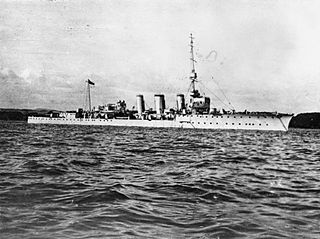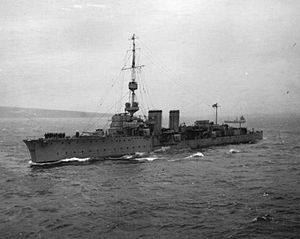
The C class was a group of twenty-eight light cruisers of the Royal Navy, and were built in a sequence of seven groups known as the Caroline class, the Calliope class, the Cambrian class, the Centaur class, the Caledon class, the Ceres class and the Carlisle class. They were built for the rough conditions of the North Sea, and proved to be rugged and capable vessels, despite being somewhat small and cramped.

HMS Calliope was a C-class light cruiser of the Royal Navy under construction at the outbreak of the First World War. Both Calliope and her sister ship Champion were based on the earlier cruiser Caroline. They were effectively test ships for the use of geared turbines which resulted in the one less funnel. They also received slightly thicker armour. They led into the first of the Cambrian subclass.

The fourth HMS Comus was a C-class light cruiser of the Royal Navy that saw service in World War I. She was part of the Caroline group of the C class.

HMS Caroline is a decommissioned C-class light cruiser of the Royal Navy that saw combat service in the First World War and served as an administrative centre in the Second World War. Caroline was launched and commissioned in 1914. At the time of her decommissioning in 2011 she was the second-oldest ship in Royal Navy service, after HMS Victory. She served as a static headquarters and training ship for the Royal Naval Reserve, based in Alexandra Dock, Belfast, Northern Ireland, for the later stages of her career. She was converted into a museum ship. From October 2016 she underwent inspection and repairs to her hull at Harland and Wolff and opened to the public on 1 July 2017 at Alexandra Dock in the Titanic Quarter in Belfast.

HMS Centaur was a C-class light cruiser of the Royal Navy that served in the First World War and the Russian Civil War. She was the name ship of the Centaur group of the C-class of cruisers.

HMS Concord was a C-class light cruiser of the Royal Navy that saw service during the First World War. She was part of the Centaur group of the C class.

HMS Canterbury was a C-class light cruiser of the Royal Navy that saw service in the First World War and the Russian Civil War. She was part of the Cambrian group of the C class.

HMS Constance was a C-class light cruiser of the Royal Navy that saw service in World War I. She was part of the Cambrian group of the C class.

HMS Champion was a C-class light cruiser of the Royal Navy that saw service during World War I. She was part of the Calliope group of the C class.

The fourth HMS Cleopatra was a C-class light cruiser of the Royal Navy that saw service during World War I and the Russian Civil War. She was part of the Caroline group of the C class.

HMS Carysfort was a C-class light cruiser built for the Royal Navy during World War I. She was one of six ships of the Caroline sub-class and was completed in 1915. Assigned to the Grand Fleet, the Harwich Force, and the Dover Patrol during the war, the ship served as a flagship for part of the war. Her only known combat was a short battle against German torpedo boats in the English Channel, although she was very active patrolling the North Sea and unsuccessfully searching for German ships. Carysfort was assigned to the Home and Atlantic Fleets after the war and was sent to the Mediterranean Fleet during the Chanak Crisis of 1922–23 to support British interests in Turkey. In 1922, she patrolled off the Irish coast during the Irish Civil War. The ship was placed in reserve after returning home in 1923 and, aside from ferrying troops overseas, remained in reserve until she was sold for scrap in 1931.

HMS Conquest was a C-class light cruiser of the Royal Navy that saw service during World War I. She was part of the Caroline group of the C class.

HMS Cordelia was a C-class light cruiser built for the Royal Navy during World War I. She was one of six ships of the Caroline sub-class and was completed at the beginning of 1915. The ship was assigned to the 1st and 4th Light Cruiser Squadrons (LCS) of the Grand Fleet for the entire war and played a minor role in the Battle of Jutland in mid-1916. Cordelia spent most of her time on uneventful patrols of the North Sea. She spent most of 1919 as a training ship before she was recommissioned for service with the Atlantic Fleet in 1920. The ship was placed in reserve at the end of 1922 and was sold for scrap in mid-1923.

SMS Berlin was the second member of the seven-vessel Bremen class of light cruisers, built for the German Kaiserliche Marine in the early 1900s. She and her sister ships were ordered under the 1898 Naval Law that required new cruisers be built to replace obsolete vessels in the fleet. The design for the Bremen class was derived from the preceding Gazelle class, utilizing a larger hull that allowed for additional boilers that increased speed. Named for the German capital of Berlin, the ship was armed with a main battery of ten 10.5 cm (4.1 in) guns and had a top speed of 22 knots.

HMS Vanquisher (D54) was a V-class destroyer of the British Royal Navy that saw service in World War I and World War II.

HMS Vectis (D51) was a V-class destroyer of the British Royal Navy that saw service in World War I and the Russian Civil War.
HMS Violent was a V-class destroyer of the British Royal Navy that saw service in World War I and was in commission from 1917 to 1937.
HMS Venetia (D53) was a V-class destroyer of the British Royal Navy that saw service in World War I and World War II.

HMS Viceroy (D91) was a W-class destroyer of the British Royal Navy that saw service in the final months of World War I and in World War II.


















